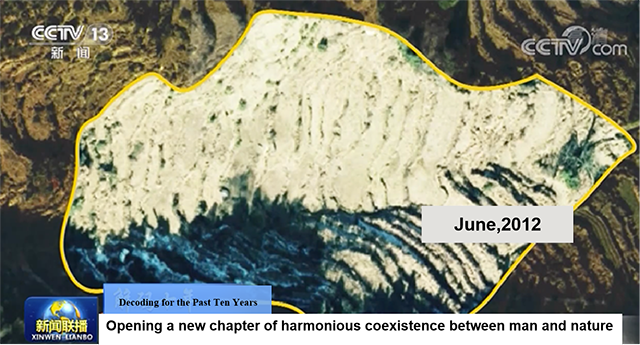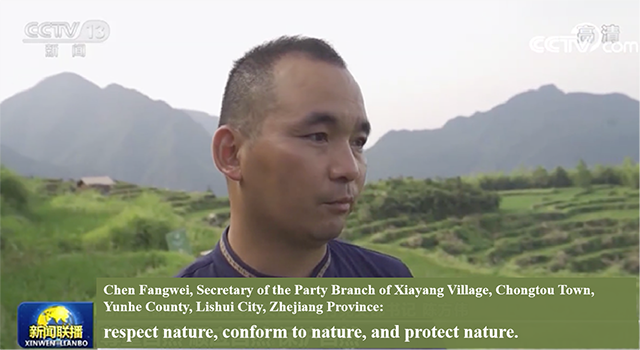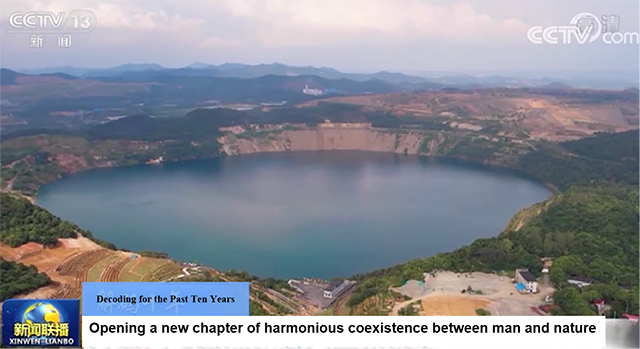



General Secretary Xi Jinping points out that "human beings should take nature as the root, respect nature, conform to nature, and protect nature." Since the 18th National Congress of the Communist Party of China, under the guidance of Xi Jinping's thought on ecological civilization, a practice of reconstructing the relationship between man and nature has taken place in China. Man and nature have opened a new chapter of harmonious coexistence.
Recently, China Central Television News (CCTV) launched a series of reports-Decoding for the Past Ten Years. Today, let's take a look at the beautiful picture of the harmonious coexistence between man and nature.
Returning the space to the nature and China has been reconstructing the relationship between man and nature in the past ten years.
Satellites in space have recorded the competition between sand and water by the Qinghai Lake for decades.
Since the 1970s, sand has been enlarged as water is decreasing for more than forty years and sand separated the sub-lakes from Qinghai Lake. But since 2012, the surface morphology here has begun a major turning point- water is enlarging and sand is decreasing. Now, sub-lakes are connected to main lake body again, and the surface has returned to the state it was more than 40 years ago.

That returning the space to the nature does not only happens in Qinghai Lake.
In the past ten years, people have used red lines to guard the areas with extremely important ecological functions and extremely fragile ecology. Among them, there are not only 5 national parks ,including giant pandas and Sanjiangyuan, but also 14 global geoparks and the first batch of 39 national grassland natural parks. In the past ten years, 9,195 nature reserves have been protected by red lines.

In the past ten years, China has reconstructed the relationship between man and nature, which not only make room for nature, but also actively participating in restoring nature.
Right now, there is a busy scene in the terraced fields of Xiayang Village in Lishui, Zhejiang Province. With the help of satellites, it can be clearly seen that ten years ago, there were large areas of dry and abandoned land in the terraced fields.

Now, when satellites capture it again, it's alive and kicking.
In 2012, Lishui in Zhejiang province began to gradually restore the Oujiang water system. Mountain spring water, along over more than 80 restored canals, flows in the terraced fields. Fish, snails and insects grow freely in the fields, forming a food chain for each other. Fish excrement becomes fertilizer and nourishes the terraced fields. Such a wetland ecological cycle system makes the terraces alive.

Chen Fangwei, Secretary of the Party Branch of Xiayang Village, Chongtou Town, Yunhe County, Lishui City, Zhejiang Province: To restore the natural ecology by natural methods is to take nature as the root, respect nature, conform to nature, and protect nature.

Ecological scars are smoothed out little by little.
The beautiful picture of the harmonious coexistence of man and nature is being drawn rapidly.
In the past ten years, the concept of harmonious coexistence between man and nature has been deeply rooted in the hearts of the people. The ecological scars on the land of China have also been healed little by little.
Yancheng, Jiangsu Province, which used to be full of tidal flats and saline-alkali land, has built a green barrier of ten thousands of acres; the Ma'anshan Aoshan Open-pit Iron Mine, which has a century-old mining history, has been filled with water to form a circular sapphire.

The once yellow and black mottled wasteland has become an oasis. In the past ten years, the Chinese have planted the world's largest plantation with their hands-the world's largest artificial forest with more than 1.1 billion acres of trees and grass .

Humans treat nature kindly, and nature will also give human beings. In the past decade, 128,000 species have been discovered and included in the Chinese Biological Species List, nearly double the number in 2011. The population of more than 300 species of endangered wild animals and plants has resumed growth. The wild population of giant pandas and Tibetan antelopes has increased significantly, and the threat level has been reduced from endangered to vulnerable ; the number of crested ibis, known as the Oriental Jewel, has increased to more than 5,000, and the total number of elk that once disappeared in the wild has exceeded 8,000 .

That the beautiful picture of the ever-present green mountains, the ever-flowing green waters, and the harmonious coexistence of man and nature are all being rapidly drawn in the hands of the Chinese.
Source: <http://www.planning.org.cn/news/view?id=12863&cid=12>
Translated by: Yue Wang